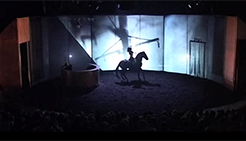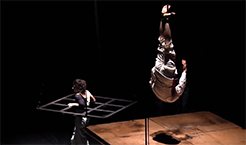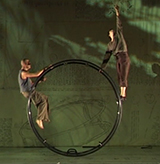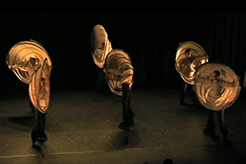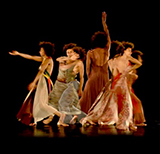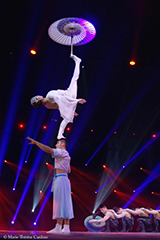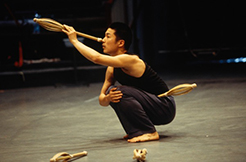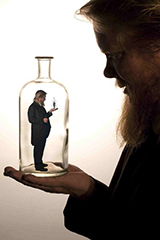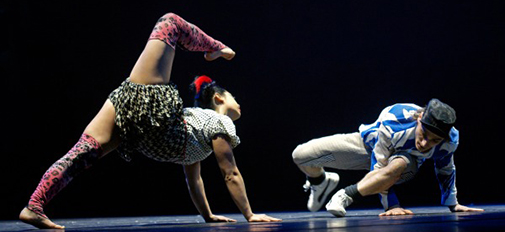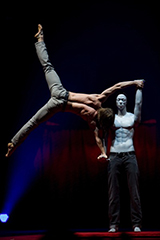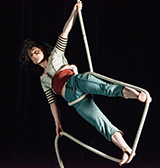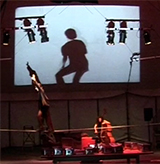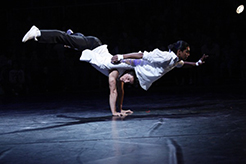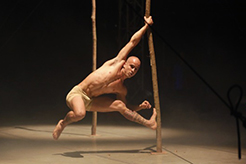in the contemporary circus
by Anne Quentin
The creation process consists of the art being created, inspired by questions prior to the act of creation, whatever the aesthetic field it may be practiced in. In the traditional circus, things are very orchestrated, immutable. The dramaturgies or the representation of movement are based on both the risk for the bodies and the feat, the transcendence, the rhythm of the ring, as well as the multiplicity of artistic exploits. The contemporary circus, on the other hand, is anchored in the contradictions of the world. The core issue has a new purpose.
Yes, there is movement and prowess, but what do you want to say?
Artists write, experiment, make choices, the gesture becomes poetry to serve a purpose. However, it does not lose its long-standing specificities: the artist is there for himself and plays no character, the circle, - even if many artists no longer play in the ring - still imposes its own movement, the laws of attraction and the balances are part of his imaginary world. And the real or sublimated risk remains a powerful constant factor. For the trampolinist Mathurin Bolze, founder of the MPTA1 company, in which he stages his own shows, "we can think that the risk has become less physical, yet I have the feeling that when an acrobat doesn't do all he can when he can, something sounds wrong. The risk is the performance and it is based on the adaptability of the individual. Performing acrobatics when you are a one-legged person or sewing with your feet for someone who doesn't have hands can be a feat. What is changing today is that the sequence is accompanied by the determination to give it everything you' ve got".
This is also the case with the clown Bonaventure Gacon: "The risk is inherent in the circus in the spectator's imagination. There is a physical risk on the part of the artist, of course, but there is also the risk of intention, of why we do this. A feat for a feat is of no interest to anyone, it's sport. "Commitment, involvement, intention, risk-taking is expressed as so many new ways of being involved in the circus until you reach the unknown, as the Finnish juggler Jani Nuutinen likes to think in terms of performance: "When I juggle cannonballs, it can be very dangerous physically, but it is not when I do this act that I feel in danger. It is more perilous for me when I do things that are much more minimalist, less obvious! Today, the risk is to find new forms."
A posture facing the world
Every act of creation begins as a posture facing the world that signs the so-called artistic universe of the artist, sometimes his obsessions, or rather the environment where his imagination prevails, which are and will remain his fundamentals. Mathurin Bolze invests his playground with the sole and ambitious desire to talk about the human being: "I want people to hear that I am talking about otherness and its differences." The acrobat and founder of the W association, Jean-Baptiste André, has made his discipline his artistic commitment: "It rubs off on your identity. I wanted to seek balance in every sense of the word. Balance and imbalance, back and forth, me and the others. It is also a more radical political concern: How could social imbalance be used in a performance situation?"
Sometimes, the adventure is characterized by some utopian vision that underlies all gestures. This is the case for Camille and Manolo of the Théâtre du Centaure, who invented with the animal, the double, half-man, half-horse actor: "Each project constitutes an aspect of our entire problem: creating, through a "true" relationship, an actor who is at once animal and human. This is our utopia of the so-called dual being. This connection to otherness creates a friction that highlights both in a confrontation between the organic and the constructed, between nature and culture. In the contemporary world, this makes sense in itself. " For some artists who challenge general intentions, intuition is the key to success. "I trust what will emerge, it happens as a necessity, whereas at the beginning it was almost nothing, a vague idea. It's buried, hidden, stowed away, until sometimes, suddenly, the magic happens..."
The meaning of prowess
Meaning is the purpose, what do we want to talk about? No work escapes this problem. This question of achievement for the sake of meaning and not for its own sake even underlies the contemporary circus. In a circle, in the air, anchored in the ground or in balance, the artist deploys his prowess in a space that generates his own imagination, his needs. No one better than the circus artist can experience in his flesh and in his art the gravity, the imbalance, the void and emptiness, the desire to fly or escape, the suffering body, confined, subjected to vertigo or to lost points of reference... The work arises from the physical experience and is a metaphor for the world. As Mathurin Bolze states: "Humanity interests me in its ambivalences made of violence and attraction, power and submission and the ability to resist and show that nothing is fixed, neither men nor organisations. The purpose is essential, but it is informed by something concrete, something real. For example, if I take a wheel: there is the person who decides on the required effort, the one who turns the wheel, the one who tries to stay in it. Three ways of being, three decision-making mechanisms. " Three ways of being in the world... The juggler Jérôme Thomas has turned his position into a true manifesto: "From the very beginning, I have wondered about what I do, I try to be right, in harmony with myself. I powerfully feel all the contradictions. I want to convey them with the strength of the poet. So, I have to be radical. " A meaning that runs through all creation, even objects or apparatus, such as those of Jani Nuutinen: " I seek to give new forms that are not based on virtuosity. I use everyday objects, or I invent instruments. The viewer does not know what can or should be done with them. We are venturing into new territory together."
Dramaturgy or the writing of a gesture
Drama has always existed in the circus. In traditional circus, it is based on risk, rhythm, fear, achievement, ideal bodies... Today, we more readily speak of a dramaturgy based on the engagement of the bodies, on the significance of the gesture. However, although the term comes from the theatre, it is not a dramaturgy in the theatrical sense. The circus rarely narrates, the artists do not interpret, they are themselves and express themselves in movement rather than in words; in a " different " performance that requires a complete presence, an overcoming of technique, a " state ". Jean-Baptiste André explains it well: "Dramaturgy is part of the tradition because it borrows figures and technique from it. But tradition works like a "penalty shootout", it must be convincing, effective, emotion is put aside, even if it exists. For me, it's about borrowing from performance but to disrupt it. I find a form of identity by seeking out physical activity, crescendo and increased power. I look for extremes: exhaustion, presence, experimentation. "
Dealing with the space first
The circus artist must play "with his face and buttocks", says multidisciplinary artist Johann Le Guillerm, who is part of a circus in a circle, with the artist in the centre. And if from now on, circus artists are more likely to be found on the stage of theatres than under a tent on circular rings, it remains that the space used is the first question that arises for the circus creator who is preparing a show. Admittedly, playing directly in front of the audience does not totally engage the artist's body, since he will always have his back out of sight of the audience. Nevertheless, unlike theatre or dance, circus is played out according to gravity, up and down. The juggler throws his balls, the trapeze artist uses gravitational forces just as much as the acrobat, the ground is never thought of as the only area of activity. Bodies are intimately linked to the total space they occupy as a volume. This is reflected in the scenographies, which are the cornerstones of most creative processes. "The circle, infinite space, unique space," says Mathurin Bolze, "conditions a composition in volume, cubic meters. It's always about flying away, about escaping. The theme is embedded in the bodies, objects and scenographic space that includes the apparatus I build for myself. This apparatus must open as many doors as possible since its function is to allow us to adopt another point of view on humanity. With lights, the scenography is the first element involved in the process. Even if the space is influenced by the constraints, the driving forces at that time. It must adapt to the bodies involved or reinvent other functions for apparatuses that have already been used."
Composing
Circus artists use a multitude of terms to describe their way of staging a "circus performance". Puzzle, strata, architecture, articulations, composition or "awareness". These terms reflect more a lack of specific terminology than a way of working. Because in the end, in the process, nothing really distinguishes the circus from other living arts. Jean Baptiste André creates his shows like puzzles: "It's a complete whole, everything starts at the same time. I improvise a lot. The writing is done as a synopsis in several parts: body/video/music. This is always done with words. I keep diaries, mixing a personal diary and creation. Like preparatory notebooks. Everything becomes sharper when I get back on the set. There is a description with three elements: light – sound – body. If I had to describe at all, I would say it's a composition, you have to mix vocabularies to qualify. "For Camille and Manolo, "the score and the staging are written little by little according to what the animal proposes until they impose themselves as a self-evident feature. It is the hand that guides the mind. Sometimes, between man and animal, we no longer know who is in charge of who. We move forward with the animal, in a technical form that we have invented, which becomes grammatical. Then this technique becomes language. The artistic gesture is interlinked, everything is linked from the moment we choose our life to the invention of our technique and our daily craft. The staging is the combination of everything that makes up the show. What matters is our own individual character, our own style, in other words, what makes us unique, our own way of looking at things. "
Mathurin Bolze has other vocabularies to describe the staging phases: "I write by families of movements and meanings, I also write rhythms, jerky or fluid. Then I look for the links to move from one sequence to another. But I can sometimes start from a material or a colour that can form a beginning. Writing is then done by associations or arrangements of ideas, objects or mental constructions. I write a grammar in which the figures serve as punctuation. They are suspenseful, that is, they must arrive at the right time, otherwise the whole thing may collapse. But I know the energy dynamics of my figures, what they consume, their weight and their impact. In fact, there are a thousand layers of composition, my job is to heighten their awareness. This architecture can break down, but I feel close to the scientists who are looking, without always finding what they expected. That is why I put a cluster of hints as a framework that forms a working protocol. This framework allows for experimentation, but it is also a space of poetry, a direction that allows words to go beyond their definition to make an image. The composition is subject to constraints: for instance, equipment on a stage set with limited mobility, which imposes choices of situations, entry and exit. There are the transitions, the articulations that we have found by reflecting on the before and after of a situation, and then the "ideal" ones that we have come up with in improvisation and that will be found in the composition: why seek to invent when the reality of the stage has been established?"
Taking the time
There is one last specificity of the process, which does not only belong to gender, but which is imperative here: time. There are steps that take a lifetime. Attraction, a project on Johann Le Guillerm's points of view began in 2001, it continues while continuing to be adapted. But this is a case in point. Elsewhere, artists create every three years on average, but build over the long term, well in advance of their creation. And if in the theatre or in dance they call it rehearsals, which take two months on average, in the circus the training is necessarily daily, it is composed of routines, tirelessly experienced. All disciplines require a very high level of technical skills, ranging from the search for apparatus to new gestures or new figures that directly feed the creation. Many artists run "laboratories", at least one to two years before the first rehearsals, when they work together to find the right harmony between their disciplines.
However, what the circus tells us today, suffering bodies, graphic duplications, outdated images that are acidic or nostalgic, abstract and archaic, is no longer what the circus of yesterday told us. The introduction of the process has made the creative landscape more complex, with authors whose universes are clearly identifiable, with minimalist or baroque aesthetics, poor or spectacular, burlesque or serious, nostalgic or avant-garde styles. An entire world has become more organised. The circus has become art. In order to be, it must be thought of, developed.
1. Compagnie MPTA : Les Mains, les Pieds et la Tête aussi.






